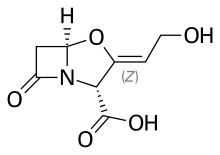Clavam
Clavams are a class of antibiotics. This antibiotic is derived from Streptomyces clavuligerus NRRL 3585.[1] Clavam is produced to form a new β-lactam antibiotic.[1] This class is divided into the clavulanic acid class and the 5S clavams class. Clavulanic acid is a broad-spectrum antibiotic and 5S clavams may have anti-fungal properties. They are similar to penams, but with an oxygen substituted for the sulfur.[2] Thus, they are also known as oxapenams.
An example is clavulanic acid,[3] from which this compound class receives its name.
Clavulanic acid, a type of Clavam, has antibiotic properties. It can be used as a medication to treat a variety of bacterial infections. CLAVAM tablets may be effective for short-term treatment of bronchitis, cystitis, sinusitis, otitis media, or skin infections.[4] Clavams are commonly used in conjunction with other antibiotics such as amoxicillin to produce a broader therapeutic effect.
Clavulanic acid strongly inhibits b-lactamase in bacteria, which is associated with its antibiotic properties. B - lactam antibiotics generally have a common feature which is the 3-carbon and 1-nitrogen ring (beta-lactam ring) that is highly reactive.[5] Different molecules of the Clavam class have been shown to inhibit the action of several fungal species. 5S Clavams do not have an inhibitory effect on b-lactamase, but are involved in methionine biosynthesis inhibition, making them bacteriostatic agents.[6] Additionally, 5S Clavams may have inhibitory effects on RNA synthesis, which is a common property of anti-fungal medications.[7] Clavams have wide-ranging bioactivity, and may have greater therapeutic use than current research indicates.[8] Because of their activity on b-lactamase, this class of antibiotics can evade antibiotic resistance in bacteria, which is a risk associated with other antibiotics such as penicillins.
Regulation of Clavam-biosynthesis in S. clavuligerus
In S Clavuligerus infection, a Streptomyces antibiotic regulatory protein known as CcaR (cephamycin and clavulanic acid regulator) are encoded into the Cephamycin gene cluster. This is essential for the cephamycin C and clavulanic acid but not the 5S claims. CcaR is important for the expression of polycistronic transcripts, which are early genes for clavulanic acid biosynthesis. This is also a key factor for activating its own transcription by binding to its own promoting region.[9]
References
- Pruess, D. L.; Kellett, M. (1983). "Ro 22-5417, A NEW CLAVAM ANTIBIOTIC FROM STREPTOMYCES CLAVULIGERUS I. DISCOVERY AND BIOLOGICAL ACTIVITY". The Journal of Antibiotics. 36 (3): 208–212. doi:10.7164/antibiotics.36.208. ISSN 0021-8820.
- "Medscape.com". Retrieved 2008-12-29.
- Chemical Research Laboratory, Oxford University (The Schofield Group). "Antibiotic Biosynthesis, Clavulanic Acid Mode of Action and Biosynthesis". Archived from the original on 2011-06-05. Retrieved 2011-07-25.
- "Clavam". NPS MedicineWise. Retrieved 2021-04-29.
- Pandey, Neelanjana; Cascella, Marco (2022), "Beta Lactam Antibiotics", StatPearls, Treasure Island (FL): StatPearls Publishing, PMID 31424895, retrieved 2022-04-04
- Jensen, Susan E (2012-10-01). "Biosynthesis of clavam metabolites". Journal of Industrial Microbiology and Biotechnology. 39 (10): 1407–1419. doi:10.1007/s10295-012-1191-0. ISSN 1476-5535. PMID 22948564.
- Röhl, F.; Rabenhorst, J.; Zähner, H. (1987-05-01). "Biological properties and mode of action of clavams". Archives of Microbiology. 147 (4): 315–320. doi:10.1007/BF00406126. ISSN 1432-072X. PMID 3304182.
- Cierpucha, Maciej; Panfil, Irma; Danh, Tong Thanh; Chmielewski, Marek; Kurzatkowski, Wieslaw; Rajnisz, Aleksandra; Solecka, Jolanta (October 2007). "Synthesis of 3-Substituted-clavams: Antifungal Properties, DD -Peptidase and β-Lactamase Inhibition". The Journal of Antibiotics. 60 (10): 622–632. doi:10.1038/ja.2007.80. ISSN 1881-1469. PMID 17965478.
- E Jensen, Susan (2012). "Biosynthesis of clavam metabolites". academic.oup.com. Retrieved 2022-05-09.
